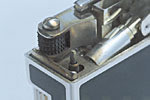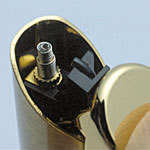User Support
Maintenance
Everybody wants to keep his or her favorite lighter at hand for a long time. That’s why maintenance is necessary. Furthermore, periodical maintenance will ensure use of the lighter at all times, preventing failure.
Flint lighter (common to gas and oil)
Change the flint before it runs out completely. Be sure to remove the old short flint before putting a new flint in.
Be sure to use a flint whose length and thickness fit your lighter.
When you will not use the lighter for along time, remove the gas and flint. When the lighter is stored with a flint inside for a long time, the flint will weather, adhering to the flint wheel or the weathered and swollen flint will cause damage to some parts.
Do not forget to remove the flint powder remaining on the flint wheel and burner nozzle using a brush provided for SAROME Flint.

Electronic piezo lighter and turbo lighter


Top: Nozzle of electronic piezo lighter
Bottom: Nozzle of turbo lighter
Dust is an enemy to electronic piezo and turbo lighters.
The ignition section clogged with dust will cause malfunction, while the burner nozzle clogged with dust will stop gas. The ignition electrode clogged with dust will prevent smooth sparking.
Do not touch the wire of the burner. The cigarette ash falling on the burner will clog the nozzle, causing defective ignition. Do not press a cigarette against the nozzle when lighting it. Keep a cigarette away from the burner.
Exercise care so as not to drop your lighter, otherwise some parts may move, causing malfunction.
The clearance between the burner nozzle and ignition electrode of an electronic piezo lighter has been adjusted on the order of millimeters. Be careful not to touch the ignition electrode when cleaning the burner nozzle with a brush.
* Turbo lighters are precision products with many parts. Use them correctly.
Oil lighter
When changing the wick, remove the outer case first, remove all the cotton from inside, and pull out the old wick. Then insert a new wick from above. The wick can be installed easily in this way.
When the tip of the wick has been burned and become sooty, pull it out by about 5 mm and cut it off with scissors.
When removing the tank from the outer case, "crunchy" sound may be produced, resulting from dust or metallic powder generated by friction between the case and tank. Wipe it off completely with a dry soft cloth.
Remove dust and soot from the hinge to allow the cap to open and close more smoothly.
